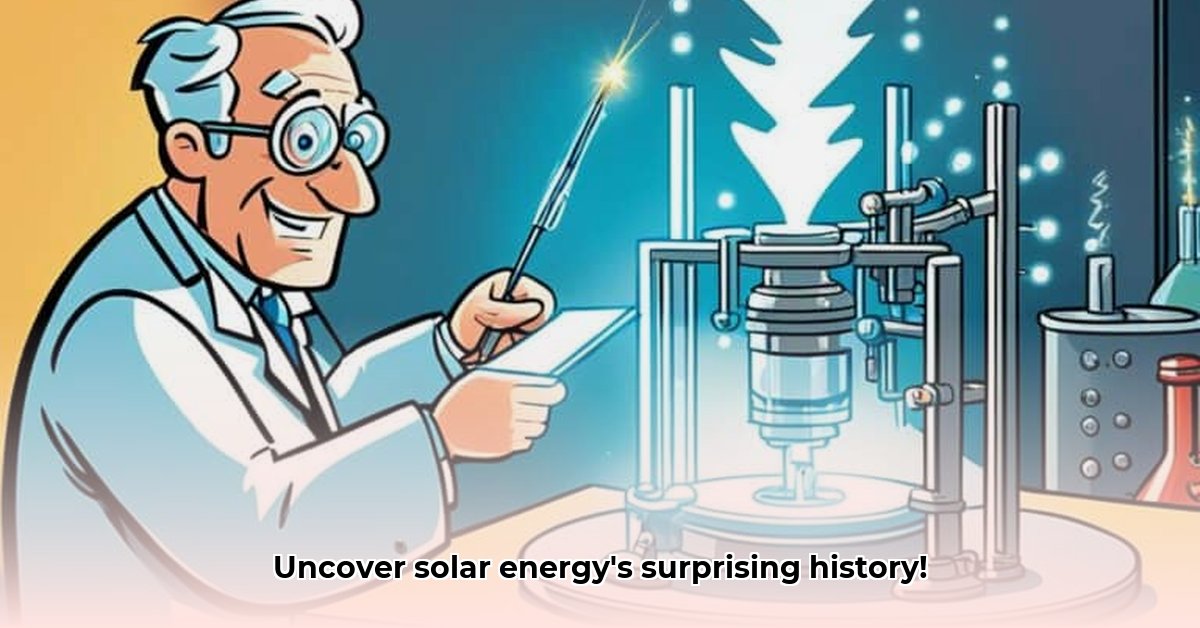So, who actually figured out how to use the sun’s power? It’s not a simple “aha!” moment, but more like a detective story spanning centuries. This isn’t just about science; it’s about the people who pushed the boundaries of what’s possible. For a deeper dive into solar energy history, check out this detailed timeline. We’ll follow the trail from the very first hints that sunlight could create electricity, all the way to the super-efficient solar panels you see on rooftops today. You’ll meet the scientists who made the breakthroughs, see how solar technology has changed over time, and even get a peek into what the future holds for this amazing energy source. Whether you’re a total expert or just curious, get ready for a fascinating journey into the world of solar energy!
Solar Energy Historical Timeline: Tracing the Roots of Clean Energy
Harnessing the sun’s power – it sounds simple enough, right? But the story of solar energy isn’t a single “eureka!” moment, but rather a fascinating relay race across centuries, with many brilliant minds passing the baton. It’s a tale of scientific curiosity, engineering breakthroughs, and the persistent push for cleaner energy.
Let’s start our journey back in 1839, with Edmond Becquerel, a French physicist with a knack for uncovering nature’s secrets. While experimenting in his father’s lab, Becquerel observed the photovoltaic effect. He discovered that when he exposed two platinum electrodes in an electrolytic solution to light, an electric current was produced. Imagine this: Becquerel discovered that certain materials could generate electricity when exposed to light. It was like finding a hidden switch that could turn sunlight into power! This was a huge deal, the foundation upon which the entire field of solar energy is built. His process involved placing two plates of either gold or platinum in a conducting solution and then exposing them to solar radiation. This discovery was so significant that the photovoltaic effect is now often referred to as the Becquerel effect. But at that point, it was mostly just a cool scientific observation. The technology to actually make something useful from it was still a long way off.
Think of it like discovering fire – amazing! – but not figuring out how to use it for cooking or warmth until much later. The same was true with Becquerel’s discovery. It was the spark, but the flame needed nurturing.
Fast forward nearly half a century to 1883. Charles Fritts, a New York-based inventor, took the next big step. Fritts built the first solar cell. Now, don’t picture sleek, modern panels. Think more along the lines of a very primitive, extremely inefficient gadget. He accomplished this by coating the mineral selenium in a thin layer of gold. It used selenium, a rare element, and only converted a tiny amount of sunlight into electricity with an energy conversion rate of 1% to 2%. It was like trying to fill a bathtub with a teaspoon – incredibly slow and frustrating! But Fritts’ creation was huge. It was proof that Becquerel’s idea could actually be turned into something tangible. This wasn’t just science anymore; it was a tiny, shaky step toward practical application.
The true revolution, however, arrived in the mid-20th century. In 1954, at Bell Labs – one of the world’s top research facilities – Daryl Chapin, Calvin Fuller, and Gerald Pearson made an incredible breakthrough. They built a solar cell using silicon, a common element, vastly improving its efficiency. Suddenly, converting sunlight into electricity wasn’t theoretical anymore. It was practical, although still quite expensive. Their invention was revolutionary; it marked a decisive moment in the history of solar power, replacing the earlier inefficient versions. It made the vision of using sunlight to power our homes a palpable possibility. Did you know that early silicon solar cells drastically improved energy conversion compared to previous models? These silicon solar cells were able to achieve about 6% efficiency.
From that point on, it was a race against time – or rather, a race against the clock toward a more sustainable future. Scientists and engineers worked relentlessly to improve these early silicon solar cells. They focused on making them cheaper to produce and more efficient at converting sunlight into power. Governments started to take notice, recognizing the environmental benefits of solar. They offered tax breaks and research grants, fueling the growth of the industry, and driving further innovation.
This is where the fascinating part of the story unfolds. It wasn’t just about technological advancement but also about economic incentives and political will. The confluence of all three factors propelled solar energy from a niche technology into a mainstream energy source. In the 1970s, the University of Delaware constructed “Solar One”, the first building powered solely by solar energy using a hybrid supply of solar thermal and solar PV power.
But the story doesn’t end there. Today, the journey continues. Researchers are constantly seeking to improve solar technology. They’re exploring new materials, like perovskites (a class of materials with a specific crystal structure), which promise even greater efficiency. They’re also tackling the challenge of energy storage – finding ways to store the sun’s power for when the sun isn’t shining.
It’s a relentless pursuit, this quest for better, more efficient ways to harvest the sun’s energy. We’re still making discoveries, tweaking designs, and finding ways to make this technology cheaper and more accessible.
So, who discovered solar energy? It wasn’t just one person. It was a team effort, a collective advancement, a century-long process. It was Becquerel’s discovery, Fritts’ ingenuity, and the Bell Labs team’s breakthrough followed by decades, perhaps even ongoing centuries of continuous improvement and refinement by countless scientists, engineers, and innovators. In essence, we all discovered solar energy. We’ve collectively unlocked the potential of the sun, inching closer every year to a future powered by clean, sustainable energy.
Timeline of Key Discoveries and Advancements
| Year | Milestone | Key Players/Organizations | Significance |
|---|---|---|---|
| 1839 | Discovery of the photovoltaic effect | Edmond Becquerel | Fundamental discovery explaining how sunlight can create electricity. |
| 1860s | Solar-powered engines | Augustin Mouchot | Registered several patents pertaining to solar-powered engines. |
| 1883 | First rudimentary solar cell (low efficiency) | Charles Fritts | First practical demonstration, although highly inefficient. |
| 1888 | Solar cells | Edward Weston | Received two patents for solar cells |
| 1954 | High-efficiency silicon solar cell | Chapin, Fuller, and Pearson (Bell Labs) | Breakthrough that significantly enhanced efficiency, making solar power more viable. |
| 1958 | Solar Powered Spacecraft | Vanguard I | First spacecraft to be powered by solar panels. |
| 1970s-Present | Continuous improvements in materials and methods | Numerous researchers, companies, and government agencies | Ongoing research focusing on efficiency, cost reduction, and broader implementation of solar power. |
Government Policies and Solar Panel Cost: Understanding the Impact
The journey to affordable solar power wasn’t a solo trek. Governments played a pivotal, often unseen, role. Let’s explore how their policies have dramatically lowered solar panel prices over time.
Early Days: A Slow Burn
Early solar technology was expensive, inefficient, and largely experimental. Think of it like the first cars—clunky, unreliable, and only for the very wealthy. Initial research was largely driven by scientific curiosity: Could we harness the sun’s energy? It wasn’t until the oil crisis of the 1970s that governments started to see solar energy as a strategic necessity, not just a science project.
The Policy Pivot: Incentivizing Innovation
This shift sparked investments in research and development. Governments realized that subsidies and tax breaks could accelerate the innovation process. How has government policy influenced solar panel cost reduction over time? By directly funding research and providing indirect support through tax incentives, governments enabled companies to develop more efficient and less expensive solar cells. This was similar to how government support for the Space Race spurred leaps and bounds in rocketry and materials science. In 1974, The Solar Energy Research, Development and Demonstration Act was passed.
The Impact of Investment Tax Credits (ITCs)
One potent policy tool has been the Investment Tax Credit (ITC). ITCs give tax breaks to those who invest in solar power systems. Imagine it like a discount coupon for cleaner energy. These credits immediately lowered the upfront cost of installing solar panels, making them more accessible to homeowners and businesses. The ITC’s impact wasn’t just on individual wallets; it created a ripple effect, driving mass adoption and encouraging increased production, leading to economies of scale and further cost reductions. The more panels manufacturers made, the cheaper they became – a classic feedback loop. The Solar Investment Tax Credit enacted in 2006 has largely contributed to solar’s average annual growth rate of 50 percent in the last 10 years in the United States
Beyond Tax Credits: A Multi-Pronged Approach
But government intervention wasn’t limited to tax breaks. Other policies played crucial roles. Renewable Portfolio Standards (RPS) mandates, which require utilities to source a certain percentage of their energy from renewables, created a reliable market for solar energy. This guaranteed demand helped companies grow and reduce their manufacturing costs, improving efficiency, and further lowering prices
- Hydro Extrusions USA Leads North American Aluminum Profile Solutions - December 28, 2025
- Hydro North America Leads Aluminum Extrusion Solutions Across Diverse Industries - December 27, 2025
- Hydro Extrusion North America Provides Custom Solutions Across Diverse - December 26, 2025
















